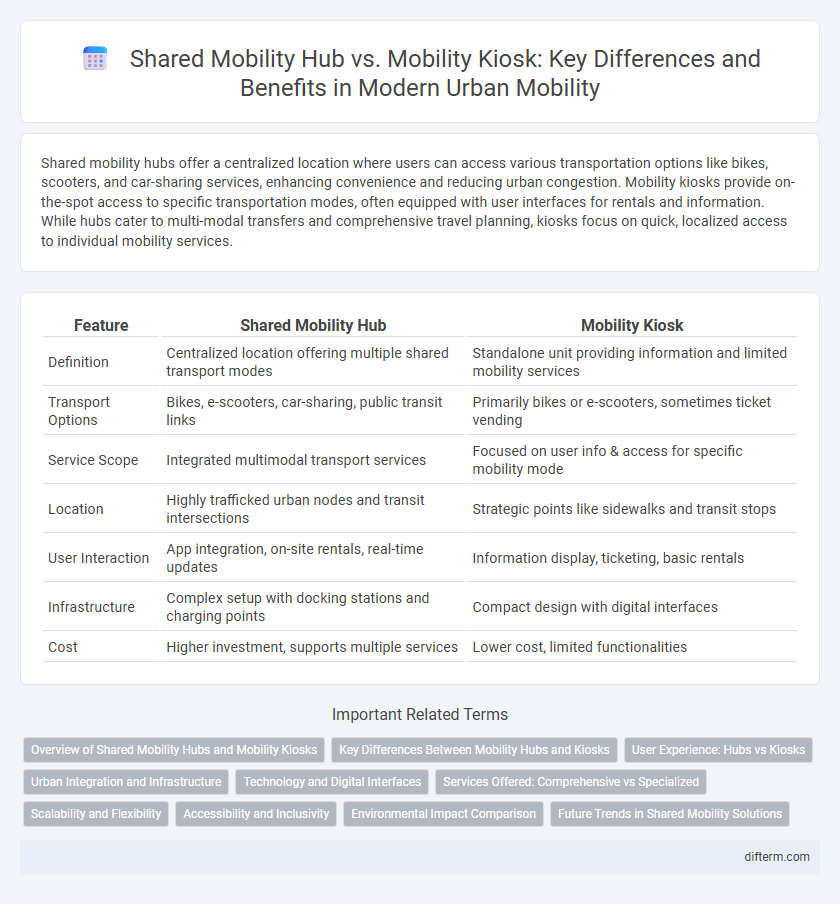Shared mobility hubs offer a centralized location where users can access various transportation options like bikes, scooters, and car-sharing services, enhancing convenience and reducing urban congestion. Mobility kiosks provide on-the-spot access to specific transportation modes, often equipped with user interfaces for rentals and information. While hubs cater to multi-modal transfers and comprehensive travel planning, kiosks focus on quick, localized access to individual mobility services.
Table of Comparison
| Feature | Shared Mobility Hub | Mobility Kiosk |
|---|---|---|
| Definition | Centralized location offering multiple shared transport modes | Standalone unit providing information and limited mobility services |
| Transport Options | Bikes, e-scooters, car-sharing, public transit links | Primarily bikes or e-scooters, sometimes ticket vending |
| Service Scope | Integrated multimodal transport services | Focused on user info & access for specific mobility mode |
| Location | Highly trafficked urban nodes and transit intersections | Strategic points like sidewalks and transit stops |
| User Interaction | App integration, on-site rentals, real-time updates | Information display, ticketing, basic rentals |
| Infrastructure | Complex setup with docking stations and charging points | Compact design with digital interfaces |
| Cost | Higher investment, supports multiple services | Lower cost, limited functionalities |
Overview of Shared Mobility Hubs and Mobility Kiosks
Shared mobility hubs provide centralized locations integrating multiple transportation options such as bike-sharing, car-sharing, and public transit connections to enhance urban mobility efficiency. Mobility kiosks serve as smaller, technology-driven touchpoints offering real-time transit information, ticketing services, and rental options for bikes or scooters. Both solutions aim to improve accessibility and convenience but vary in scale and functionality within the shared mobility ecosystem.
Key Differences Between Mobility Hubs and Kiosks
Mobility hubs serve as integrated transportation centers combining multiple shared mobility options like bike-sharing, e-scooters, public transit, and car rentals in a single location, enhancing seamless multimodal travel. Mobility kiosks primarily function as interactive points for accessing specific services such as ticketing, vehicle rental, or real-time transit information, often focusing on convenience and user interface rather than multi-transport integration. Key differences include scale and scope, with hubs offering comprehensive mobility ecosystems and kiosks providing targeted, user-centric access to individual mobility services.
User Experience: Hubs vs Kiosks
Shared mobility hubs offer a seamless, integrated user experience by consolidating various transportation options such as bike-sharing, car rentals, and public transit in one accessible location, reducing transfer times and enhancing convenience. Mobility kiosks primarily provide localized, single-service access points, which may limit the scope of user interaction but allow for quick, specific transactions like ticket purchases or vehicle rentals. Users benefit from hubs' comprehensive service range and real-time digital interfaces, while kiosks serve as essential touchpoints for targeted, immediate needs within urban mobility networks.
Urban Integration and Infrastructure
Shared mobility hubs optimize urban integration by centralizing various transport modes--bikes, scooters, car shares--within well-designed infrastructure that supports seamless transfers and reduces congestion. Mobility kiosks, typically smaller and standalone, offer limited services focused on quick access or information but lack the extensive infrastructure to support multimodal integration at scale. Infrastructure investments in shared mobility hubs encourage sustainable urban development and improve connectivity across neighborhoods.
Technology and Digital Interfaces
Shared mobility hubs integrate advanced technology platforms and digital interfaces to facilitate seamless multimodal transport options such as bikes, scooters, and car-sharing services, promoting efficient trip planning through real-time data and app-based reservations. Mobility kiosks typically feature touch-screen interfaces and digital displays designed for quick, localized access to transport information, ticketing, and micro-mobility services, but with a narrower scope than hubs. The key distinction lies in the hubs' comprehensive digital ecosystem enabling interconnected mobility services, while kiosks focus on streamlined, user-friendly technology for immediate transit needs.
Services Offered: Comprehensive vs Specialized
Shared mobility hubs offer comprehensive services including bike rentals, electric scooters, car sharing, and public transit integration, catering to diverse commuting needs within a single location. Mobility kiosks provide specialized services focused on specific transportation modes, such as bike or scooter rentals, with limited additional amenities. The comprehensive nature of shared mobility hubs enhances multimodal connectivity, while mobility kiosks target streamlined, mode-specific user experiences.
Scalability and Flexibility
Shared mobility hubs offer greater scalability by integrating multiple transportation modes such as bikes, scooters, and car-sharing services in a centralized location, enabling efficient expansion with urban growth. Mobility kiosks provide flexibility by serving as modular, standalone access points that can be easily relocated or customized to meet changing demand patterns. The combination of hubs' comprehensive service range and kiosks' adaptable deployment supports dynamic, scalable urban mobility networks.
Accessibility and Inclusivity
Shared mobility hubs centralize various transport options, offering seamless access to bikes, scooters, and ride-shares within one location, enhancing inclusivity for urban populations with diverse mobility needs. Mobility kiosks provide localized, user-friendly interfaces with real-time information and ticketing services, facilitating access for individuals with disabilities through tactile buttons and audio support. Both solutions expand accessibility but hubs tend to serve broader transit integration, while kiosks focus on immediate, on-site user engagement and assistance.
Environmental Impact Comparison
Shared mobility hubs significantly reduce carbon emissions by integrating multiple transport modes like bikes, e-scooters, and electric vehicles, promoting low-emission travel and reducing private car dependency. Mobility kiosks primarily serve as information points or rental stations, limiting their direct environmental benefits to efficient vehicle access rather than emission reductions. Studies show shared mobility hubs contribute to a measurable decrease in urban air pollution and traffic congestion compared to standalone mobility kiosks.
Future Trends in Shared Mobility Solutions
Shared mobility hubs integrate diverse transportation modes such as bike-sharing, e-scooters, and car rentals into centralized locations, enhancing user convenience and promoting sustainable urban mobility. Mobility kiosks serve as interactive points providing real-time information, booking services, and payment options, supporting seamless access to shared transportation. Future trends emphasize the expansion of smart hubs equipped with IoT technology and AI-driven analytics, optimizing multimodal transit and responding dynamically to urban travel demand.
shared mobility hub vs mobility kiosk Infographic

 difterm.com
difterm.com